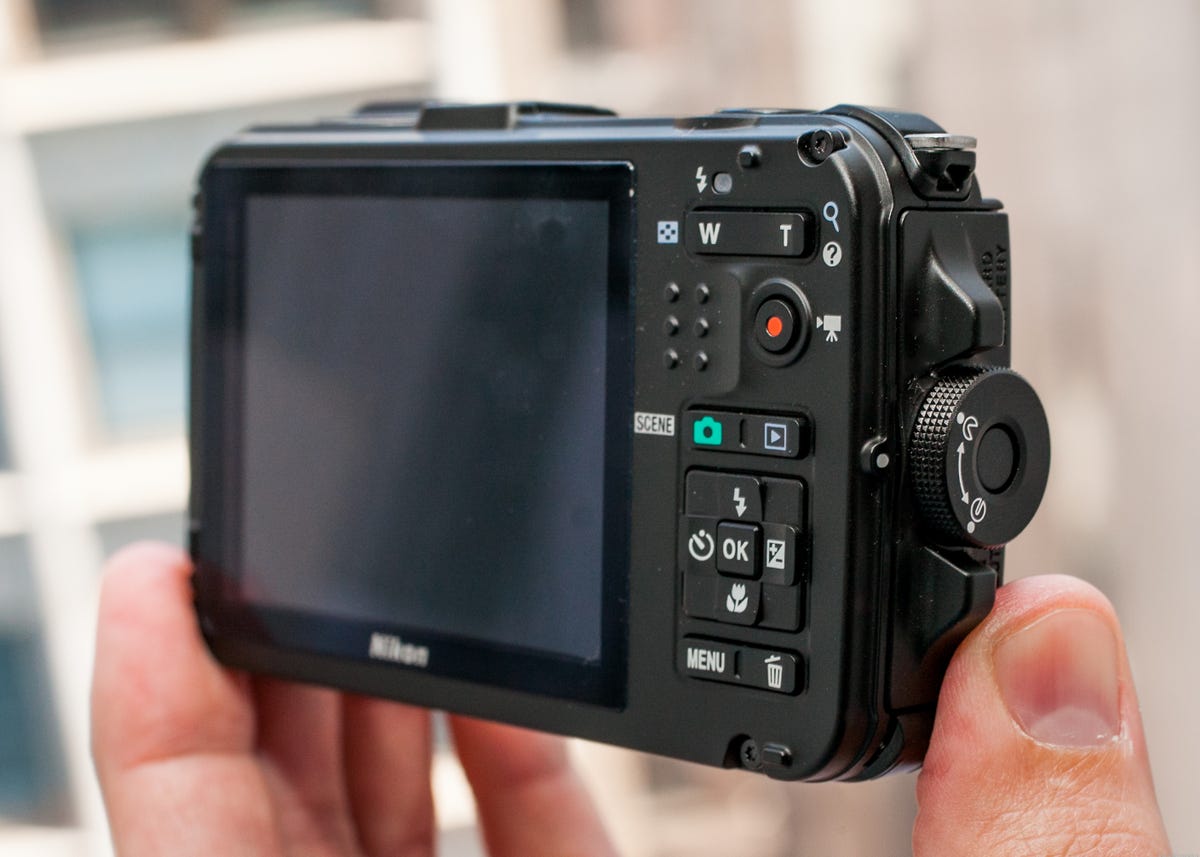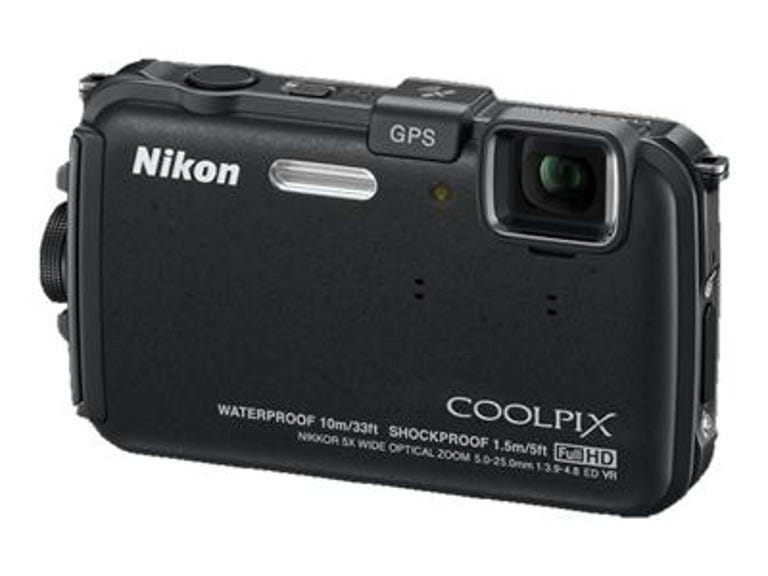 Why You Can Trust CNET
Why You Can Trust CNET Nikon Coolpix AW100 review: Nikon Coolpix AW100
A slow lens keeps this high-end tough camera from being a better low-light performer.
Nikon came late to the rugged compact camera party, but its first entry, the Coolpix AW100, arrived prepared to handle some fairly rough treatment. It's rated to be waterproof down to 33 feet, shockproof to 5 feet, and freezeproof to 14 degrees Fahrenheit.
The Good
The Bad
The Bottom Line
Like all rugged cameras, it has limitations as to what it can actually survive, and Nikon is more upfront about that than most manufacturers.
To go along with its durability, there's a built-in GPS receiver for geotagging your photos, an electronic compass, and Action Control (which is very similar to Olympus' Tap Control), which lets you change settings by tapping the sides of the camera or shaking it.
The rest of the features and shooting options are similar to what you'd find on other higher-end Coolpix cameras, so all in all, it's a pretty good rugged compact. But, much like the AW100's ruggedness, the rest of the camera has some limitations, too, that might make you think twice about picking one up.
Picture quality
If you're considering a rugged compact to take diving, the Nikon Coolpix AW100 is probably not the one you want. While it's capable of taking some very good photos when you have plenty of light, its small maximum aperture requires you to use either higher ISOs or slow shutter speeds to get a shot with less light; for better or worse, the camera regularly goes with the latter.
Overall, the AW100's photos are best suited for prints up to 8x10 inches or Web use without a lot of enlarging or cropping. When viewed at 100 percent, there are visible artifacts and noise even at its lowest sensitivity of ISO 125. Subjects look soft, too (not unusual for rugged cameras), and could stand some post-shoot sharpening.
As you move up in sensitivity, photos get softer and softer, and color quality starts to deteriorate. At and above ISO 800, subjects look flat with muted colors. Basically, this camera's high-ISO photos aren't great and coupled with its slow lens, it's hard to recommend it for use in low light.
That said, if you're more of a snorkeler or pool denizen, or want a rugged camera for snow or offroad sports, it can take some very good photos. You can read more about picture quality in the slideshow above.
Movie quality is also decent, though again, the more light you have the better things will look. The AF assist lamp can be turned on and used to brighten close subjects. The zoom lens does work while recording; you won't hear it move necessarily, but you will hear the press and release of the zoom rocker. Also, if you turn on the continuous AF function, you may hear the camera focusing in your movie.
Shooting performance
In our lab tests, the AW100 was a pretty fast camera. It goes from off to first shot in less than a second and has a very low shutter lag of 0.2 second in bright lighting, which increases to 0.5 second in low light. Shot-to-shot times are a little more average, but still good at 1.6 seconds without flash and 1.9 seconds with. The camera's full-resolution continuous burst is capable of 7.1 frames per second, though it can only do it for three shots and takes several seconds before it's ready to shoot again.
The camera generally performed the same in anecdotal testing, however it did occasionally have problems focusing. Several times during testing I was greeted with an "Initializing lens. Cannot focus." error that basically locked down the camera until it recovered. Also, when shooting in macro mode from time to time, the camera would say it was focused on my subject, but actually wouldn't be.

Design and features
The AW100 certainly looks the part of a rugged point-and-shoot, but it's not overdone. You can tell it's different, but it doesn't stick out. Aside from the large knob on the right side and the long button on the left (more on those in a bit), all the controls are pretty typical of what you'd find on Nikon's other Coolpix models. However, the buttons are small and tightly spaced, which can result in some accidental presses. Also, the buttons feel very spongy and were occasionally unresponsive, likely because of the waterproofing below them. The body is kind of slippery, too, especially when wet, and there's nothing really to grip on to.
On the right side of the camera is a single door protecting the battery, card slot, Mini-HDMI port, and Micro-USB port. Having everything under one door limits access points for water and the door has a nice big seal on it as well as a lock that requires you to push in a button while turning a knob, so it's fairly secure. I say fairly because if you for some reason forget to turn the knob all the way till you hear the button click, the door can be closed but not locked.
Another sticking point for me is that the battery is charged with an external adapter. Normally, this doesn't bother me, but for a rugged camera to require an outlet and charger is silly. If it charged over USB you'd have other options for refilling your battery. If you're considering the AW100 for a trip where you won't have an outlet for awhile, you'll want to bring an extra battery or two.
| Key specs | Nikon Coolpix AW100 |
|---|---|
| Price (MSRP) | $349.95 |
| Dimensions (WHD) | 4.4 inches by 2.6 inches by 0.9 inch |
| Weight (with battery and media) | 6.3 ounces |
| Megapixels, image sensor size, type | 16 megapixels, 1/2.3-inch CMOS |
| LCD size, resolution/viewfinder | 3-inch LCD, 460K dots/None |
| Lens (zoom, aperture, focal length) | 5x, f3.9-4.8, 28-140mm (35mm equivalent) |
| File format (still/video) | JPEG/H.264 AAC (.MOV) |
| Highest resolution size (still/video) | 4,608x3,456 pixels/1,920x1,080 at 30fps |
| Image stabilization type | Optical and digital |
| Battery type, CIPA rated life | Lithium ion rechargeable, 250 shots |
| Battery charged in camera | No |
| Storage media | SD/SDHC/SDXC |
| Bundled software | ViewNX 2 (Windows, Mac) |
GPS performance has been solid on other Coolpix cameras, and that's the case with the AW100. Turning it on and off doesn't require as much menu diving as other GPS-enabled cameras I've tested, but it does require some effort.
A button on the left side of the camera brings up the camera's map information, and if the GPS is on and locked on a satellite, it will display your current location. It can be used to geotag photos as well as display and embed points of interest. You can also use the GPS to keep a log of your path while you shoot.
Even if you turn off the camera, the GPS receiver stays active, searching for your position every 30 minutes for up to 6 hours. If it can't find your position it will start searching every 15 minutes for an hour. Needless to say, all of this taxes your battery life, which isn't all that great to begin with. If you're not going to be shooting for a while, make sure you turn it off.
The same button on the left can be used for the camera's Active Control system. Again, the buttons on the AW100 are really a little too small and close together to use underwater or with gloved hands. Active Control lets you shake and tap the camera to change shooting modes, enter playback, or start movie recording. It can be handy, but it's something you'll want to shut off when you don't need it.
One last thing: Nikon includes a plastic adapter that snaps onto the lens, allowing you to add 40.5mm filters such as a polarizer to the camera. It's similar to what's included with the Pentax WG-2, but attaches better. It is, however, not as nice as the lens adapter for Olympus' TG-1 iHS that allows you to add on waterproof lenses.
| General shooting options | Nikon Coolpix AW100 |
|---|---|
| ISO sensitivity (full resolution) | Auto (125-800), 125, 200, 400, 800, 1600, 3200 |
| White balance | Auto, Daylight, Incandescent, Fluorescent, Cloudy, Flash, Manual |
| Recording modes | Auto, Easy Auto, Scene, Special Effects, Smart Portrait |
| Focus modes | 9-point AF, Manual AF (99-point selectable), Center AF, Subject tracking AF, Macro |
| Macro | 0.4 inch (Wide) |
| Metering modes | Matrix, Center-weighted |
| Color effects | Sepia, High-contrast Monochrome, High Key, Low Key, Selective color, Soft |
| Burst mode shot limit (full resolution) | Three shots |
The AW100's shooting options are pretty much the same as you'd find on Nikon's other high-end Coolpix cameras -- lots of auto options, not much direct control over results. There are two Auto modes: One is Nikon's Easy Auto mode, which adjusts settings appropriately based on six common scene types or an underwater mode when lowered into water. If the scene doesn't match any of those, it defaults to a general-use Auto. Then there is an Auto mode, which is like the Program mode on other point-and-shoots. You can change ISO, white balance, and exposure compensation as well as autofocus area and mode and continuous shooting.
There are 18 scene modes with standards such as Landscape and Portrait as well as an Underwater mode, a Pet Portrait mode that will automatically shoot when it detects a cat or dog face, and an Easy Panorama mode. Just press the shutter and pan the camera left, right, up, or down to create a panorama in camera.
There is a Special Effects mode, too, for those who want to get just a little more creative with their photos; a Backlighting mode that uses the flash or combines multiple exposures to improve backlit subjects; a handheld Night Landscape mode, which also uses a burst of shots and combines them to reduce blur and noise; and a smile-detecting, skin-softening, blink-warning Smart Portrait mode.
Nikon includes several extra editing features in the playback menu, as well. These include D-Lighting, which helps enhance highlights and shadows; Quick Retouch that punches up contrast and saturation; several filter effects like fisheye, miniature, and selective color, which lets you pick a color in your scene and turns the rest of your photo monochrome; and Glamour Retouch for softening skin, reducing face size, and enlarging eyes.
Conclusion: Recommended with reservations
As a first effort, the Nikon Coolpix AW100 is a decent rugged compact if you're doing most of your shooting on land. The dark lens and average low-light photo quality are a better match for hiking or snow sports or shooting in shallow waters in full sun, but not diving, regardless of its waterproof rating.
The GPS performance in my review camera was solid and turning it on and off is easier than in most competing rugged compacts. Photo and video quality are very good if you have a lot of light and you don't need large prints or mind doing a little sharpening after you shoot. If it were still priced at $379, I'd pass, but it's currently selling for less than $300, which makes it easier to recommend for its rugged specs and features.
(Shorter bars indicate better performance)
| Time to first shot | Typical shot-to-shot time (flash) | Typical shot-to-shot time | Shutter lag (dim) | Shutter lag (typical) |
(Longer bars indicate better performance)


